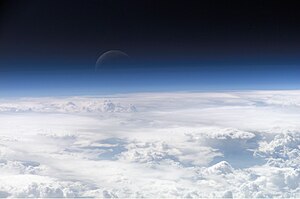Monday, January 11, 2010
From Wikipedia, the free encyclopedia
(Redirected from Air)
Jump to: navigation, search
"Air" redirects here. For other uses, see Air (disambiguation).

Blue light is scattered more than other wavelengths by the gases in the atmosphere, giving the Earth a blue halo when seen from space
The atmosphere of Earth is a layer of gases surrounding the planet Earth that is retained by Earth's gravity. The atmosphere protects life on Earth by absorbing ultraviolet solar radiation, warming the surface through heat retention (greenhouse effect), and reducing temperature extremes between day and night. Dry air contains roughly (by volume) 78% nitrogen, 21% oxygen, 0.93% argon, 0.038% carbon dioxide, and small amounts of other gases. Air also contains a variable amount of water vapor, on average around 1%.
The atmosphere has a mass of about five quintillion (5x1018) kg, three quarters of which is within about 11 km (6.8 mi; 36,000 ft) of the surface. The atmosphere becomes thinner and thinner with increasing altitude, with no definite boundary between the atmosphere and outer space. An altitude of 120 km (75 mi) is where atmospheric effects become noticeable during atmospheric reentry of spacecraft. The Kármán line, at 100 km (62 mi), also is often regarded as the boundary between atmosphere and outer space.
Composition
Main article: Atmospheric chemistry
| ppmv: parts per million by volume (note: volume fraction is equal to mole fraction for ideal gas only, see Gas volume#Partial volume) | ||||
| Gas | Volume | |||
|---|---|---|---|---|
| Nitrogen (N2) | 780,840 ppmv (78.084%) | |||
| Oxygen (O2) | 209,460 ppmv (20.946%) | |||
| Argon (Ar) | 9,340 ppmv (0.9340%) | |||
| Carbon dioxide (CO2) | 387 ppmv (0.0387%) | |||
| Neon (Ne) | 18.18 ppmv (0.001818%) | |||
| Helium (He) | 5.24 ppmv (0.000524%) | |||
| Methane (CH4) | 1.79 ppmv (0.000179%) | |||
| Krypton (Kr) | 1.14 ppmv (0.000114%) | |||
| Hydrogen (H2) | 0.55 ppmv (0.000055%) | |||
| Nitrous oxide (N2O) | 0.3 ppmv (0.00003%) | |||
| Xenon (Xe) | 0.09 ppmv (9x10−6%) | |||
| Ozone (O3) | 0.0 to 0.07 ppmv (0% to 7x10−6%) | |||
| Nitrogen dioxide (NO2) | 0.02 ppmv (2x10−6%) | |||
| Iodine (I) | 0.01 ppmv (1x10−6%) | |||
| Carbon monoxide (CO) | 0.1 ppmv | |||
| Ammonia (NH3) | trace | |||
| Not included in above dry atmosphere: | ||||
| Water vapor (H2O) | ~0.40% over full atmosphere, typically 1%-4% at surface | |||




0 comments:
Post a Comment